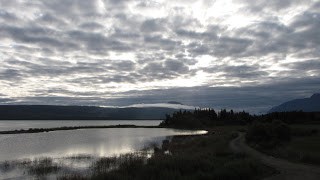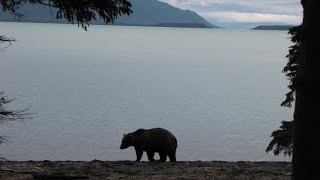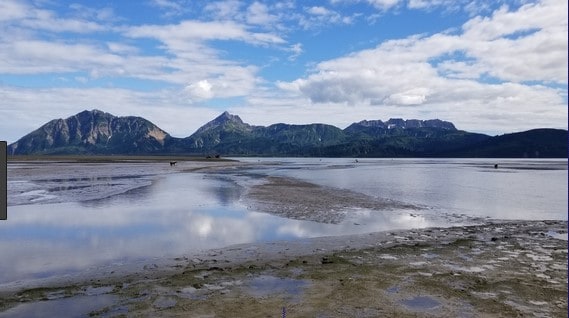Early Morning over Naknek Lake and the spit road

Change is happening. Brooks Camp is in serious countdown mode – the days left until we close down for the season number in the single digits as of Thursday 9/09. On Saturday 9/18 we will do it all in the reverse of last May as we start boxing up t-shirts, books, pins, and zipper pulls from the bookstore and packing them all away in the auditorium, cleaning the ranger station where we have used the computers and the phone (when it was working) all summer, washing and dusting and mopping our own cabins to leave them as clean as we found them when we arrived, and bringing all our belongings down to the beach to load onto the Park float plane for the final trip back to King Salmon on Tuesday 9/21. I also have one more item on my personal agenda – I leave this Friday evening (9/10) to start my third (yikes!) attempt to hike to Novarupta. It is the absolute last weekend I will be able to do it.
The endless daylight of the Alaskan mid-summer is slowly easing itself into the darkening nighttime hours of early autumn, for autumn is surely settling itself in on the Alaska Peninsula. Summer is over when the flower buds on the tips of the common fireweed have bloomed completely. Along the road to the Valley of Ten Thousand Smokes the fireweed’s bright pink blooms are nearly spent; its leaves everywhere are turning maple-crimson, color rising upward toward the sky from the bottom of the stalk. Against the deep green hillside background of white spruce, the shrub alder and cottonwoods are spreading wide swathes of golden-yellow across Dumpling Mountain behind camp and Mt. Lagorce over across Naknek Lake.
I checked the almanac and on June 21, the solstice, sunrise was at 5:16 AM and sunset was at 11:40 PM with the length of visible light at King Salmon being 21 hours and 24 minutes. But the sky never really got dark – at around 2 a.m. there was still the faint light of waning dusk (or was it the onset of dawn?) overhead, and I never needed a flashlight if I went outside or peeked out the window from beneath my polka-dotted flannel sheets. This past Saturday (9/4/10) sunrise was at 7:31 AM and sunset was at 9:17 PM with the length of visible light being 15 hours and 10 minutes. I now take my headlamp with me if I plan on walking back to my cabin anytime after 9:00 p.m. The light here at 58° north latitude of Katmai decreases an average of 5 minutes per day this time of year.
Another change is that the bears are back. After having fished at Brooks Falls for all of July they took off up lake 20 miles to Margot Creek during August where the salmon had migrated later than at Brooks River. August was a relatively quiet month for Katmai park rangers, with few visitors and fewer bears – we had some 3-day weekends and a lot of project time. Minnesota Sue blew into Katmai mid-month for a week of fun times. Then BOOM!!! September arrived and the bears came back to the lower Brooks River to feed on the spawned-out dead and dying salmon moving downstream with the current. Visitors are back, too, and “bear-jams” are common. No, bear-jams are NOT meant to describe the eau-de-salmon scented bear droppings that are splattered all over the trails – bear-jams are bridge closures. Since the bears are fishing primarily at the lower river now (and not upriver at the Falls) the bridge across the lower river is more often than not closed to pedestrian traffic because of bears being nearby. Not only are bears nearby, they are everywhere. They pop out of the marsh and the willows. They pop out onto the trail behind you and next to where you happen to be standing. They pop out onto the beach at the ranger station trail or at the campground. There are darling spring cubs (born in the den in January) and sub-adults running around and chewing on everything in their path. Older females lounge about on the beach unconcerned about anything, and adult males actually play with each other, less competitive now that their bellies are full of salmon.



I was sitting on the lodge porch around 10:30 the other night enjoying a “colorado bulldog” (a white russian with a splash of coke but my bartender prefers a splash of Baileys) when a big old brown bear lumbered slowly by about 25 feet away. My “Bear at the lodge!” alarm was a futile gesture as the bear lumbered on, disappearing into the inky darkness of the trail toward the river. Need I mention that the number of colorado bulldogs ingested had absolutely nothing to do with my reaction time?
So we will have fewer hours of daylight as we hike out to the USGS hut on Baked Mountain, 9 miles up the Valley from the Three Forks visitor center. It should take us about 5 hours to get to the hut. Novarupta is 2-3 miles further and we will save that for the second day out. I invested in a 2-pound, 12-ounce GoLite backpack specifically for this trip, I have my sleeping bag scrunched into a compression sack, and I will wear pretty much the same pants and tops for the entire 3 days. I have a few “just-in-case” items like extra food and clothes, we are borrowing a Jet-boil stove, and we will get our water from a spring at the 6-mile campsite where our route into the Valley takes us away from the base of the Buttress Range. Jeanette and Robert will be my traveling companions for this adventure. I’ll return Monday night.






